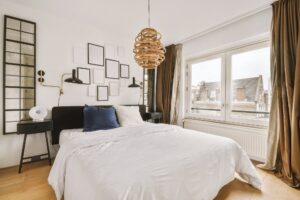Textile trends are dynamic & ever-changing due to shifting consumer tastes, rapid technological development, & environmental concerns. Textile design and production are undergoing a revolution, with products ranging from eco-friendly and sustainable fabrics to eye-catching patterns. The most recent developments in textile design will be examined in this piece, along with eco-friendly materials, technological advancements, performance and multipurpose textiles, striking patterns, textured and embossed textiles, bold patterns, & personalized designs. Sustainable and environmentally friendly fabrics are in high demand as consumers become more aware of how their purchases affect the environment.
Key Takeaways
- Textile trends are constantly evolving and influenced by various factors such as consumer preferences, technology, and sustainability.
- Sustainable and eco-friendly fabrics are gaining popularity due to increasing awareness about environmental impact and the need for more responsible production methods.
- Technological innovations in textiles, such as 3D printing and smart fabrics, are revolutionizing the industry and offering new possibilities for design and functionality.
- Multi-functional and performance fabrics are in demand for their ability to provide comfort, durability, and specialized features for different applications.
- Bold and vibrant textile patterns are making a statement in fashion and interior design, adding a pop of color and personality to products.
- Textured and embossed fabrics are creating tactile interest and adding depth to designs, appealing to both visual and tactile senses.
- Customization and personalization in textile design are becoming more accessible, allowing consumers to create unique and individualized products.
Innovative materials like organic cotton, bamboo, hemp, and recycled polyester have been developed as a result. These textiles provide greater comfort and performance in addition to being better for the environment. Apart from utilizing sustainable materials, the textile industry is also adopting environmentally friendly production techniques like waterless dyeing and zero-waste production. New standards for sustainability in the textile industry are being set by these innovations, which are changing the way textiles are made and used.
Recent years have seen a significant increase in the textile industry’s focus on eco-friendly and sustainable materials. Eco-friendly products are becoming more and more popular among consumers in addition to being fashionable and useful. The creation of sustainable materials that have a minimal environmental impact has therefore been a focus for textile manufacturers.
Organic cotton, which is cultivated without the use of artificial fertilizers or pesticides, is one of the most widely used sustainable textiles. This improves the working conditions for farmers while also lessening the environmental impact of cotton production. Bamboo is another eco-friendly fabric that is becoming more & more popular. In order to grow quickly and with little need for pesticides or water, bamboo is a highly renewable resource.
Because of this, bamboo fabric is a great option for clothing and home textiles because it is not only very soft and breathable but also sustainable. Apart from bamboo and organic cotton, hemp has also become a viable substitute for conventional textiles in terms of sustainability. Hemp is an eco-friendly option for making fabrics since it grows quickly, needs little water, and doesn’t require pesticides. In addition to being more environmentally friendly, these sustainable textiles perform and feel better, which makes them a desirable choice for customers trying to buy less and reduce their environmental impact. Technological innovations are revolutionizing the design, production, and use of fabrics in the textile industry. These innovations are expanding the realm of what is feasible in the textile industry, from smart textiles to sophisticated manufacturing processes.
One of the most fascinating advancements in textile technology is 3D printing, which enables designers to produce elaborate and sophisticated fabric structures that were previously unattainable using conventional techniques. This has created new opportunities for making distinctive, individualized textiles that suit personal tastes. Smart textiles are revolutionizing the way we think about fabric in addition to 3D printing.
Textiles that have been technologically enhanced to create interactive and useful materials—such as conductive fibers or sensors—are known as smart textiles. These textiles have many uses, including home décor, fashion, healthcare, and sports performance. Using smart textiles, apparel that monitors vital signs & modifies its temperature in response to outside factors is just one example of what can be made.
Technological advancements are not only expanding the realm of textile design possibilities, but they are also creating new avenues for the production of fabrics that are more useful and adaptable to our needs. Future textile trends are being shaped by performance and multipurpose textiles in addition to sustainability and technology breakthroughs. These fabrics are perfect for a variety of applications since they are made to provide improved functionality and performance.
Moisture-wicking material, which is intended to pull moisture away from the skin to keep the wearer dry and comfortable, is one type of multipurpose fabric. In sportswear & activewear, where performance is a top priority, this kind of fabric is frequently used. UV-protective fabric, which is made to ward off the sun’s damaging UV rays, is another illustration of a performance textile. This kind of fabric is frequently used to further protect against the sun’s rays in outdoor apparel and accessories. Multifunctional materials with qualities like stain, wrinkle, and odor resistance are available in addition to fabrics that are moisture-wicking and UV-protective. These materials are made to offer more functionality and convenience, which makes daily living easier.
Multipurpose textiles are anticipated to become more significant in the textile sector as customers look for goods with greater performance and adaptability. Vibrant and colorful patterns are now very popular in textile design, giving apparel, accessories, and home decor a splash of color & personality. These striking patterns are making an impact in the textile industry, ranging from geometric prints to floral motifs.
Using strong colors and geometric shapes to create visually arresting designs is one of the most popular trends in pattern design. Both fashion designers and interior decorators have embraced this trend, incorporating vibrant patterns into their designs to infuse them with vitality and excitement. Traditional patterns like stripes, plaids, and polka .s have also seen a comeback in addition to vivid colors and geometric shapes. With their striking color schemes and oversized scales, these traditional patterns have been given a modern makeover, giving them a sleek, new appearance. Using elements from nature, like animal patterns and botanical prints, is another popular trend in pattern design.
These patterns add a sense of peace and a sense of belonging to nature to our homes and closets by bringing a little bit of the outdoors in. Bright and vivid patterns are bringing life and excitement to textiles in all forms, whether it’s through a striking geometric pattern on a throw pillow or a bold floral print on a dress. An important trend in textile design, textured and embossed fabrics give accessories, apparel, and home décor more depth and dimension. Beyond just being aesthetically pleasing, these textiles are producing a tactile experience with raised patterns and tactile surfaces.
The jacquard fabric, with its elaborate woven patterns that give the surface of the fabric a raised texture, is one of the most well-liked textured fabrics. This kind of fabric is often used to add tactile appeal and visual interest to draperies and upholstery. Because they can imprint three-dimensional patterns on flat surfaces, embossed fabrics—along with jacquard—have also gained popularity. Embossing is a technique that adds depth and texture to fabric by pressing a pattern into it with heat or pressure.
To create opulent textures that resemble exotic animal skins or intricate embossed designs, this technique is frequently applied to leather and faux leather fabrics. Apart from jacquard & embossed textiles, classic textured materials like chenille, tweed, and bouclé have also seen a comeback in popularity. These textiles are a desirable option for customers looking for comfort and luxury because they provide a tactile feel that warms and cozies apparel and home furnishings.
The ability for customers to create unique products that express their unique style and preferences has made customization and personalization popular trends in textile design. With options like custom-printed fabrics and embroidered shirts, customers are having more control over their purchases than ever before. Personalized embroidery, which enables customers to add their initials or a unique design to apparel, accessories, and home textiles, is one of the most well-liked types of customization. This makes commonplace objects feel special & unique by adding a personal touch. Custom-printed fabrics have gained popularity due to their capacity to produce unique designs that cater to individual preferences, in addition to personalized embroidery.
Thanks to developments in digital printing technology, customers can now design unique patterns and hues for wallpaper, upholstery, and clothes. Customers are free to express their creativity in new ways thanks to the limitless possibilities this presents for textile design. Made-to-order apparel, which lets customers select the fabric, style, and fit for a genuinely customized item, is another type of customization that has grown in popularity.
By giving consumers more control over design, this trend is changing the way we perceive fashion. In summary, as technology develops, consumer tastes shift, and sustainability gains prominence, textile trends are ever-changing. The textile industry is going through a design and production revolution, with sustainable fabrics, multifunctional materials, textured fabrics, bold patterns, and customization options among its many innovations. By providing more sustainable options, cutting-edge functionality, captivating visual appeal, tactile experiences, and personalized products that reflect unique style preferences, these trends are revolutionizing the way we think about textiles.
These trends will surely continue to influence textiles for years to come as they continue to grow.
Discover how to elevate your home decor with the latest textile trends in interior design. From luxurious velvet to sustainable linen, these fabrics are transforming interiors and creating a stylish and inviting atmosphere. If you’re looking for more inspiration on how to enhance your living space, check out this insightful article on how to decorate a small living room with a sectional couch. Whether you’re a first-time renovator or a seasoned decorator, these tips will help you create a beautiful and functional space that reflects your personal style.
FAQs
What are some current textile trends in interior design?
Some current textile trends in interior design include the use of sustainable and eco-friendly fabrics, bold and vibrant patterns, and textured materials such as bouclé and velvet.
How are sustainable fabrics transforming interior design?
Sustainable fabrics are transforming interior design by offering environmentally friendly options that reduce the industry’s carbon footprint. These fabrics are often made from recycled materials or produced using eco-friendly processes.
What role do bold and vibrant patterns play in interior design textiles?
Bold and vibrant patterns add personality and visual interest to interior spaces. They can be used to make a statement or create a focal point within a room.
How are textured materials such as bouclé and velvet influencing interior design?
Textured materials like bouclé and velvet are adding depth and tactile appeal to interior design. These fabrics create a sense of luxury and coziness, making them popular choices for upholstery and soft furnishings.
What are some popular color palettes in interior design textiles?
Popular color palettes in interior design textiles include earthy tones such as terracotta and olive green, as well as calming shades of blue and green. These colors are often used to create a sense of tranquility and connection to nature within interior spaces.





